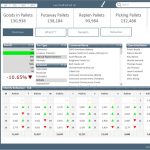

 Modern businesses need proper applications to support all aspects of their operations and to exchange information with suppliers and customers. Any business operating in the supply chain will probably see Warehouse Management Software (WMS) as key. But many still rely on systems that do not support easy data exchange and integration with other applications. Could this be limiting their business opportunities?
Modern businesses need proper applications to support all aspects of their operations and to exchange information with suppliers and customers. Any business operating in the supply chain will probably see Warehouse Management Software (WMS) as key. But many still rely on systems that do not support easy data exchange and integration with other applications. Could this be limiting their business opportunities?
The ability to work with partners, suppliers and customers easily and with seamless transactions is a key part of the modern supply chain. Anything that compromises the swapping and sharing of relevant and useful information not only adds costs and complexity but could also present a barrier to doing business altogether.
Businesses are likely to have invested in specialist applications that are used internally and across their supply chain. These will include sales, accounting, manufacturing management, resource planning, eCommerce, and many more. They will achieve this by deploying applications and technologies at each stage and enabling them to integrate and exchange information with each other. Increasingly this also means the warehouse management or stock control system.
 The benefits of WMS for efficient stock management and order processing are generally well established but they clearly offer other advantages in the extended supply chain. When dealing with customers the WMS can provide the real-time stock availability that enhances customer perceptions and helps to drive sales.
The benefits of WMS for efficient stock management and order processing are generally well established but they clearly offer other advantages in the extended supply chain. When dealing with customers the WMS can provide the real-time stock availability that enhances customer perceptions and helps to drive sales.
Several studies have shown that customers make buying decisions based not just on knowing that the item they want is in stock but that it will be delivered to a convenient location at a suitable time. Good WMS enables this through integration with, among others, eCommerce and delivery management applications.
 Dealing with suppliers is another area where WMS reduces complexity. For example, suppliers can send advance information about deliveries to be held on the WMS until they arrive. The WMS then uses the information to verify those incoming orders and allocates stock to appropriate warehouse locations to ensure availability for sale and despatch. There is no need for the warehouse team to input data, saving time and removing the potential for rekeying errors.
Dealing with suppliers is another area where WMS reduces complexity. For example, suppliers can send advance information about deliveries to be held on the WMS until they arrive. The WMS then uses the information to verify those incoming orders and allocates stock to appropriate warehouse locations to ensure availability for sale and despatch. There is no need for the warehouse team to input data, saving time and removing the potential for rekeying errors.
The supplier and warehouse operator also save money because everything is faster and more accurate. This is a basic example, but it is surprising how many businesses still do not do it.
 Another example is real-time stock visibility which can help suppliers plan their scheduled deliveries. This is especially useful in retail and manufacturing supply chains where just-in-time (JIT) lead times are short and deliberately designed to be “lean”. Real-time visibility helps suppliers identify what to deliver and by when, to maintain sufficient inventory levels in the warehouse. The supplier can access the WMS via a web interface, or integration with their own inventory application, often using automated triggers to instigate when, for example, warehouse stock levels fall below pre-set thresholds. In scenarios like this the WMS will reflect the genuine situation in the warehouse – the very definition of real-time – and anything that gets in the way has the potential to cause delays and disruption.
Another example is real-time stock visibility which can help suppliers plan their scheduled deliveries. This is especially useful in retail and manufacturing supply chains where just-in-time (JIT) lead times are short and deliberately designed to be “lean”. Real-time visibility helps suppliers identify what to deliver and by when, to maintain sufficient inventory levels in the warehouse. The supplier can access the WMS via a web interface, or integration with their own inventory application, often using automated triggers to instigate when, for example, warehouse stock levels fall below pre-set thresholds. In scenarios like this the WMS will reflect the genuine situation in the warehouse – the very definition of real-time – and anything that gets in the way has the potential to cause delays and disruption.
 Another scenario will be familiar to businesses supplying food, pharmaceuticals, healthcare, chemicals, electronic goods, precision engineering products, and other items that require high degrees of traceability. Here, being able to identify items at the batch, case, or even single pack/item level is not just a business differentiator but can be a matter of regulatory and/or legal compliance. Businesses with this requirement need to be sure that they have – or can access – detailed information about an item at every step along the supply chain so that they can verify its provenance and provide that information when asked. WMS can provide that information for the warehousing and delivery phases if not others as well.
Another scenario will be familiar to businesses supplying food, pharmaceuticals, healthcare, chemicals, electronic goods, precision engineering products, and other items that require high degrees of traceability. Here, being able to identify items at the batch, case, or even single pack/item level is not just a business differentiator but can be a matter of regulatory and/or legal compliance. Businesses with this requirement need to be sure that they have – or can access – detailed information about an item at every step along the supply chain so that they can verify its provenance and provide that information when asked. WMS can provide that information for the warehousing and delivery phases if not others as well.
All these scenarios, and many others, can be managed using paper-based systems. But why do it that way when perfectly good information applications are available? While it might be a stretch to claim suppliers will never want to do business, it is not difficult to imagine situations where the complexity and cost of doing things the old-fashioned way would simply make it not worth the effort.
 Deploying a WMS therefore offers the ability to work more easily with customers and removes a potential barrier to supply chain collaboration and partnership. The most immediate benefit is internal with all the advantages of accurate and efficient warehouse stock management. For many businesses that would be justification enough but here we are talking about the benefits of data exchange and integration with internal and third-party (customer and supplier) applications. Modern WMS supports this by using APIs (Application Programming Interfaces). These allow applications from different vendors or developers to communicate with little or no additional configuration. This makes it very easy for connected applications to exchange data, especially when it is in popular or common formats.
Deploying a WMS therefore offers the ability to work more easily with customers and removes a potential barrier to supply chain collaboration and partnership. The most immediate benefit is internal with all the advantages of accurate and efficient warehouse stock management. For many businesses that would be justification enough but here we are talking about the benefits of data exchange and integration with internal and third-party (customer and supplier) applications. Modern WMS supports this by using APIs (Application Programming Interfaces). These allow applications from different vendors or developers to communicate with little or no additional configuration. This makes it very easy for connected applications to exchange data, especially when it is in popular or common formats.
 We’ve been delivering clever Warehouse Management Software (WMS) and Enterprise Resource Planning (ERP) solutions for over 30 years. We love to develop innovative responses that optimise our customer’s operations, add new revenue-generating value-added services, reduce OpEx and deliver required ROI.
We’ve been delivering clever Warehouse Management Software (WMS) and Enterprise Resource Planning (ERP) solutions for over 30 years. We love to develop innovative responses that optimise our customer’s operations, add new revenue-generating value-added services, reduce OpEx and deliver required ROI.